|
|
|
|
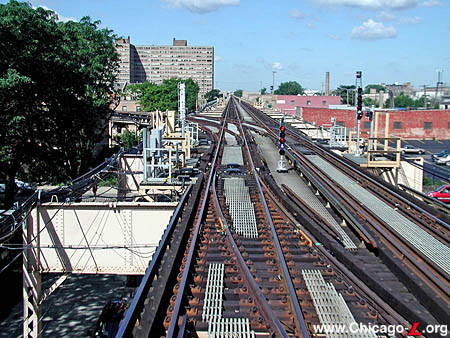 Paulina Junction, where outbound Pink Line trains diverge onto the Paulina Connector as Green Line trains continue west to Harlem/Lake, is seen looking west on August 13, 2004. For a larger view, click here. (Photo by Graham Garfield) |
|
|
|
|
 Paulina Junction, where outbound Pink Line trains diverge onto the Paulina Connector as Green Line trains continue west to Harlem/Lake, is seen looking west on August 13, 2004. For a larger view, click here. (Photo by Graham Garfield) |
Paulina
Junction
Paulina Avenue and Lake
Street, Near West Side
Service Notes:
Services:
Green Line: Lake
Pink Line: 54/Cermak-Loop
Quick Facts:
Established: April 4, 1954
Original Line: Douglas/Paulina Connector & Lake Line
Rebuilt: 2004-05
Status: In Use
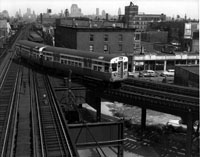
In this 1954 view, a Douglas train of 6000s turns south from Lake Street at Paulina Junction on their way out to Cicero-Berwyn Terminal. For a larger view, click here. (Photo from the CTA Collection) |
During the construction of the Congress Line in the median of the Congress Street Superhighway (now the Eisenhower Expressway), Douglas trains were rerouted via the Lake Street elevated to reach the Loop. To accomplish this, a section of the nonrevenue Paulina Connector (the former Metropolitan Division Northwest branch) was reactivated. Originally, the Northwest branch passed over the Lake Street elevated, but did not have a junction with it. To get Douglas trains onto the Lake Street elevated, a new connection had to be built. Thus, a new connection was built from the Connector to the Lake Street elevated adjacent to the fly-over and abandoned Lake Street Transfer station where the two crossed. The short, curved section of elevated structure met the Connector at Washington Junction and hooked into the Lake Line at what became Paulina Junction.
On April 4, 1954, the CTA reactivated the Paulina Connector between Congress and Lake and Paulina Junction came into use. Initially, the interlocked junction was operated by a towerman, controlled from a tower panel. The tower was located in a small white-exterior building constructed at the south end of the former northbound platform of Lake Street Transfer station, a high perch which gave the towerman an excellent view of the junction below to the east and the approaching Lake and Douglas trains to determine which class of train was approaching and set the switches in advance.
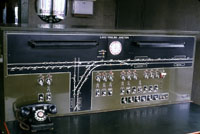
The interlocking control panel inside the Lake-Paulina Tower (aka the "White House", due to the building's exterior appearance) is seen on July 25, 1955. Note the old rotary-style phone on the panel's desk, and the mirror and hand towel dispenser on the wall behind (a sink is most likely being obscured by the tower panel). The tower panel is a type known as "unit lever". For a larger view, click here. (Photo by B.L. Stone, courtesy of the Krambles-Peterson Archive) |
An innovative step toward fully-automated operation of a non-terminal crossover was taken in August 1954 when the interlocking plant installed at Paulina Junction four months earlier was modified. What was new was a way of automatically sorting the westbound trains, differentiating between Douglas and Lake trains. Trains used a device called a Train Identification Coil or "Identra-Coil" (sometimes nicknamed "the toilet seat" because of its shape). This was an electronic device carried on the right side of the lead car of each Douglas train. The motorman obtained the coil before the beginning of his run from the terminal clerk when going on duty and returned it when going off-duty (unless directly relieved by a motorman requiring use of the coil). The motorman inserted the coil in a bracket mounted on the right front of the train.
As a train approached the junction, a carborne electronic device (e.g. the coil) passed in front of a trackside electronic receiver device which automatically set the proper switches for the train. Since only Douglas trains carried the coils, the presence of a coil set the switch for the Paulina Connector. Otherwise, the switch was aligned for the Lake route by default. If the correct route failed to be automatically set by the transmitter, the motorman could manually set the route by operating levers on the wayside route selector. Eastbound, routing was set simply on a first-come, first-served basis.
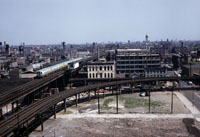
This aerial view of the Lake/Paulina complex shows a car transfer of eight 6000-series cars moving along the old Met Northwest branch. Both the old Met line and lower curved track linking the Connector to the Lake Street "L" were only used for nonrevenue service by the time of this June 24, 1961 view. The white building to the right of the train on the northbound platform of the old Lake Street Transfer station housed the signal equipment required to operate Paulina Junction on the right, but by this time was no longer used to control the junction. For a larger view, click here. (Photo by J.J. Buckley, courtesy of the Krambles-Peterson Archive) |
On August 20, 1954, the CTA began automatic operation of Paulina Junction. By the summer of 1958, construction of the new Congress Line was largely complete. As part of the project, a new ramp was designed and built in the vicinity of Paulina Street that connected the Douglas elevated with the median-level Congress Line. On June 22, 1958, the Congress Line officially opened. Henceforth, Douglas trains would be rerouted via this ramp to the Congress Line at Loomis Junction. Operations of Douglas trains via the Paulina Connector and Lake Street elevated were discontinued. The "Identra Coil" system was used at Loomis Junction, where the Douglas would connect to the Congress Line, which had superseded Paulina Junction as the Douglas trains' way of reaching downtown.
The automatic interlocking plant actually stayed at Paulina Junction for a few years, although it was no longer needed for regular revenue operation. Finally, on March 16, 1960, the automatic equipment was removed. Hand-throw switches were mounted in their place. Paulina Junction remained a manually-operated junction for the next several decades.
Reactivation of Interlocking Plant
Effective Sunday, June 25, 2006, the majority of Douglas trains used a new Pink Line routing, sending them to the Loop via the Paulina Connector and Lake branch rather than to O'Hare via the Congress Line. This meant that for the first time in almost 50 years revenue trains would need to be sorted at Paulina Junction, with outbound Pink Line trains bound for the Paulina Connector differentiated from the Green Line trains that would need to continue west on the Lake branch. As full-time staffing of the junction was not a desirable alternative, the CTA devised an automated train sorting system to use as part of the new interlocking plant it would install at the junction.
During 2004-05, new switches, relay houses, and a tower panel were installed at Paulina Junction. When the Pink Line began operating, the interlocking was staffed by a towerman at all times, but in autumn 2006 the CTA began testing an Automatic Vehicle Identification (AVI) train sorting system. The 22 railcars assigned to the Pink Line were outfitted with transponders called "AVI tags" which, when they pass over detectors on the right-of-way, automatically put in the route for Pink Line. The default outbound route at the junction is for Green Line trains, which had no transponders. No vehicle identification was necessary inbound, since these trains are merged at the junction rather than sorted; inbound Green and Pink line trains simply receive a route and clear signal on a first come, first served basis. The system was similar to how Green and Orange line trains were sorted at 17th Tower and northbound at Tower 12. If train operators receive an incorrect lineup at Paulina Junction, wayside route selectors are available to allow the operator to cancel and enter the correct lineup.
As of 2007, Paulina Junction was operated with the automatic train sorting system, staffed only during rush periods and other high-traffic periods.
The practice of equipping Pink Line-assigned trains with transponders continued for several years. It was a somewhat cumbersome practice, because only cars assigned to the Pink Line were equipped with them, which meant anytime assigned cars were transferred to or from Pink Line service, the transponder had to be installed or removed, or the cars would not register with the wayside detector and the incorrect default (Green Line) route would be set at the junction.
This changed after the Pink and Green lines was fully equipped with 5000-series railcars. The 5000s are all equipped with AVI tags; these were included on the all the cars of that series as part of their base equipment as built and delivered by the manufacturer. Further, rather than only transmitting one hard-coded identification, the tags are integrated with the railcar's systems, so the train transmits what route and destination it is based on the terminal/destination entered by the train operator on the car's Train Operator's Touch Screen (TOTS) interface in the motorcab at the beginning of the trip (the same input sets the train's destination signs, marker lights, and pre-recorded announcement sequence). Therefore, currently the wayside receiver for Paulina detects the route/terminal identification signal from the passing train and sets the appropriate route at the junction. This method, based on the destination of the train actually set by the operator rather than the presence or absence of a transponder helps prevent operators from getting the incorrect route at the junction. This system only works for 5000-series trains, however, as only the 5000s have the carborne equipment to transmit this information to the wayside receiver. If no destination has been entered on a 5000-series train, or the train is made up of older equipment, the interlocking will establish the default route (which is still for the Green Line) and the operator is required to use the wayside route selector to establish the desired route if it is different than what the interlocking automatically set.
Relay House Fire
On the evening of March 28, 2016, a small fire in one of two signal bungalows at Paulina Junction caused the interlocking equipment to fail. The failure of the interlocking meant that in order to route trains, switches would have to be thrown by hand and trains flagged through -- a less than desirable scenario at a junction where there is a train movement every few minutes. The fire also rendered inoperative the cab signaling system in that general area.
Green Line trains continued to operate "on sight" through the affected area with the switches having been manually set and locked for the tangent straight-through route. After a brief service interruption, Pink Line service was rerouted to the Racine station on the Blue Line using the long ramp in the Eisenhower Expressway median that extends from Harrison Junction to Loomis Junction where it joins the Blue Line tracks -- the ramp formerly used by Cermak (Douglas) trains when they were through-routed to the Northwest Side as part of the Blue Line. Pink Line trains then pulled into the Morgan Middle Track where they “changed ends” (reversed direction) for their return trip, pulled back into Racine to pick up passengers connecting from Blue Line trains, and headed back up the ramp to resume their normal route to 54th/Cermak. Passengers had to use Blue Line trains between Racine and downtown.
Following the fire, CTA Signal crews worked to obtain needed parts and begin the slow and laborious task of replacing the damaged electrical equipment and wiring. By the end of that week, the work had been completed to the point that it was possible to resume Pink Line operation through Paulina Junction effective with the first morning train on Sunday April 3. However, the repairs were temporary, with more permanent work requiring the assistance of outside contractors. Ragnar Benson Construction was awarded a contract to fully repair the relay house and signal equipment, with work underway by fall 2016. Work was substantially completed in early 2017, allow normal, automatic operation of the interlocking. However, some additional work and testing continued until March 2018, at which time the interlocking plant was considered to be fully operational again.
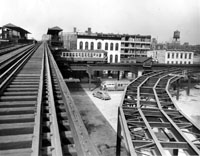 |
ROW@Lake1954.jpg (192k) Looking north from atop the old Met Northwest branch tracks, the new link between the Paulina Connector and the Lake Street "L" is under construction in this early 1954 view. Once completed, Douglas trains will use it to temporarily access the Loop while the new Congress Line is completed. Lake Street Transfer station, closed for about three years, is visible on the left, while a Lake Street train of 4000-series cars emerges from under the old Met "L" on its way to the Loop. (CTA photo) |
 |
tour00l.jpg
(89k) |
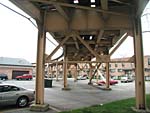 |
ROW@Lake01.jpg
(161k) |
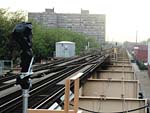 |
PaulinaJct01.jpg
(232k) |
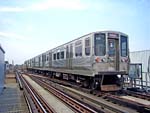 |
cta2222b.jpg
(174k) |
|
|